
Aakriti Jain
@aakritijain.bsky.social
Postdoc in Roberto Zoncu's lab at UC Berkeley.
Interested in #organelles, #metabolism, #membranes, #enzymes, #cancer, #neurodegeneration 🙂
Side interests include #cats, #beers, #pastries 🙃
Interested in #organelles, #metabolism, #membranes, #enzymes, #cancer, #neurodegeneration 🙂
Side interests include #cats, #beers, #pastries 🙃
Pinned
Aakriti Jain
@aakritijain.bsky.social
· Mar 27
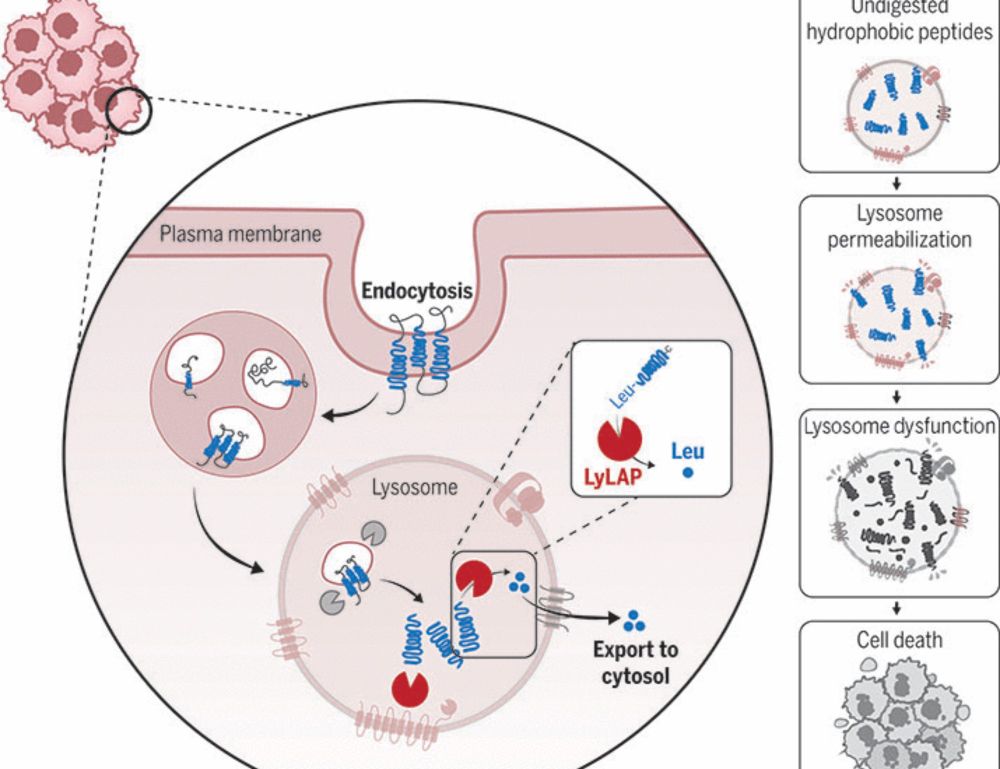
Leucine aminopeptidase LyLAP enables lysosomal degradation of membrane proteins
Breakdown of every transmembrane protein trafficked to lysosomes requires proteolysis of their hydrophobic helical transmembrane domains. Combining lysosomal proteomics with functional genomic dataset...
www.science.org
SO excited to share that a major part of the postdoctoral work in @robzonculab.bsky.social lab is now published: “Leucine aminopeptidase LyLAP enables lysosomal degradation of membrane proteins” www.science.org/doi/10.1126/...
Reposted by Aakriti Jain
Excited to share our work @nature.com! Postdoc @mariopalma.bsky.social, with major contributions from @retickerflynn.bsky.social and collaborators, discovered melanoma cells in lymph nodes gain a targetable FSP1 dependency that limits progression. #TeamFSP1
www.nature.com/articles/s41...
www.nature.com/articles/s41...
Lymph node environment drives FSP1 targetability in metastasizing melanoma | Nature
www.nature.com
November 5, 2025 at 4:11 PM
Excited to share our work @nature.com! Postdoc @mariopalma.bsky.social, with major contributions from @retickerflynn.bsky.social and collaborators, discovered melanoma cells in lymph nodes gain a targetable FSP1 dependency that limits progression. #TeamFSP1
www.nature.com/articles/s41...
www.nature.com/articles/s41...
Reposted by Aakriti Jain
1/New paper from Zheng Wu, Phong Nguyen et al. @cri-utsw.bsky.social shows how cells balance the two pathways that produce purine nucleotides: de novo purine biosynthesis (DNPB) and purine salvage. The surprising mechanism involves NUDT5, a Nudix hydrolase
www.science.org/doi/10.1126/...
www.science.org/doi/10.1126/...

NUDT5 regulates purine metabolism and thiopurine sensitivity by interacting with PPAT
Cells generate purine nucleotides through de novo purine biosynthesis (DNPB) and purine salvage. Purine salvage represses DNPB to prevent excessive purine nucleotide synthesis through mechanisms that ...
www.science.org
November 6, 2025 at 7:01 PM
1/New paper from Zheng Wu, Phong Nguyen et al. @cri-utsw.bsky.social shows how cells balance the two pathways that produce purine nucleotides: de novo purine biosynthesis (DNPB) and purine salvage. The surprising mechanism involves NUDT5, a Nudix hydrolase
www.science.org/doi/10.1126/...
www.science.org/doi/10.1126/...
Reposted by Aakriti Jain
Excited to share my postdoc work @olzmannlab.bsky.social! We found lipid droplets, the cell’s lipid storage depots, are subject to oxidative damage and are protected by FSP1. Loss of FSP1 triggers droplet peroxidation and cell death, revealing a new layer of lipid quality control!
shorturl.at/B5XYD
shorturl.at/B5XYD

FSP1-mediated lipid droplet quality control prevents neutral lipid peroxidation and ferroptosis - Nature Cell Biology
Lange et al. identify a lipid droplet quality control pathway in which FSP1 safeguards stored neutral lipids from lipid peroxidation, thereby preventing the induction of ferroptosis.
www.nature.com
October 29, 2025 at 8:45 PM
Excited to share my postdoc work @olzmannlab.bsky.social! We found lipid droplets, the cell’s lipid storage depots, are subject to oxidative damage and are protected by FSP1. Loss of FSP1 triggers droplet peroxidation and cell death, revealing a new layer of lipid quality control!
shorturl.at/B5XYD
shorturl.at/B5XYD
Reposted by Aakriti Jain
Excited to share our latest work out today in @cp-molcell.bsky.social, revealing a molecular link between succinate dehydrogenase and purine synthesis, connecting two fundamental metabolic pathways. Huge congratulations to the first author, Mushtaq Nengroo! www.sciencedirect.com/science/arti...
!
!

Accumulation of succinate suppresses de novo purine synthesis through succinylation-mediated control of the mitochondrial folate cycle
The de novo purine synthesis pathway is fundamental for nucleotide production, yet the role of mitochondrial metabolism in modulating this process rem…
www.sciencedirect.com
October 28, 2025 at 4:25 PM
Excited to share our latest work out today in @cp-molcell.bsky.social, revealing a molecular link between succinate dehydrogenase and purine synthesis, connecting two fundamental metabolic pathways. Huge congratulations to the first author, Mushtaq Nengroo! www.sciencedirect.com/science/arti...
!
!
Reposted by Aakriti Jain
Thrilled to announce the launch of my lab
@cri-utsw.bsky.social at UTSW this January!
We will explore how cells sense and respond to mechanical forces, focusing on membrane mechanics to reveal how tension and signaling work together to shape cell behavior.
@cri-utsw.bsky.social at UTSW this January!
We will explore how cells sense and respond to mechanical forces, focusing on membrane mechanics to reveal how tension and signaling work together to shape cell behavior.
We're growing! Our newest Investigator @henrydebelly.bsky.social will join the CRI Tissue #Regeneration Program in January 2026. Learn more about Henry ➡️ cri.utsw.edu/faculty/henr... and 📌apply to research in his lab cri.utsw.edu/careers

October 16, 2025 at 10:00 PM
Thrilled to announce the launch of my lab
@cri-utsw.bsky.social at UTSW this January!
We will explore how cells sense and respond to mechanical forces, focusing on membrane mechanics to reveal how tension and signaling work together to shape cell behavior.
@cri-utsw.bsky.social at UTSW this January!
We will explore how cells sense and respond to mechanical forces, focusing on membrane mechanics to reveal how tension and signaling work together to shape cell behavior.
Reposted by Aakriti Jain
Excited to share our new preprint, led by Kirandeep Deol! 🤩 Genetic screens uncover mechanisms regulating FSP1 abundance in cancer. Vitamin B2 metabolism promotes FSP1 stability via FAD synth / binding, further linking nutrient metabolism to ferroptosis.
www.biorxiv.org/content/10.1...
www.biorxiv.org/content/10.1...

Vitamin B2 metabolism promotes FSP1 stability to prevent ferroptosis
Ferroptosis, a regulated form of cell death driven by excessive lipid peroxidation, has emerged as a promising therapeutic target in cancer. Ferroptosis suppressor protein 1 (FSP1) is a critical regul...
www.biorxiv.org
August 6, 2025 at 3:21 PM
Excited to share our new preprint, led by Kirandeep Deol! 🤩 Genetic screens uncover mechanisms regulating FSP1 abundance in cancer. Vitamin B2 metabolism promotes FSP1 stability via FAD synth / binding, further linking nutrient metabolism to ferroptosis.
www.biorxiv.org/content/10.1...
www.biorxiv.org/content/10.1...
Reposted by Aakriti Jain
Go check out the latest preprint from Giulia Zanetti's lab. @dr-downes.bsky.social used cryo-tomography to directly visualize COPI and COPII coated vesicles in situ at unprecedented resolution in human cells. Amazingly beautiful, rigorous, insightful work.
www.biorxiv.org/content/10.1...
www.biorxiv.org/content/10.1...

Multi-scale Molecular Imaging of Human Cells reveals COPI and COPII Vesicles at ER Exit Sites
Trafficking from the endoplasmic reticulum to the Golgi apparatus comprises the first steps toward the correct localization of 30% of eukaryotic proteins. Coat protein complexes COPII and COPI are inv...
www.biorxiv.org
August 4, 2025 at 11:35 AM
Go check out the latest preprint from Giulia Zanetti's lab. @dr-downes.bsky.social used cryo-tomography to directly visualize COPI and COPII coated vesicles in situ at unprecedented resolution in human cells. Amazingly beautiful, rigorous, insightful work.
www.biorxiv.org/content/10.1...
www.biorxiv.org/content/10.1...
Reposted by Aakriti Jain
And it's out!
I'm thrilled to share our new paper (Adriaenssens et al., Nat Cell Biol 2025).
This paper describes a new mechanism for the initiation of autophagosome biogenesis.
We found that this WIPI-ATG13-driven pathway is preferentially used by a group of transmembrane autophagy receptors.
I'm thrilled to share our new paper (Adriaenssens et al., Nat Cell Biol 2025).
This paper describes a new mechanism for the initiation of autophagosome biogenesis.
We found that this WIPI-ATG13-driven pathway is preferentially used by a group of transmembrane autophagy receptors.
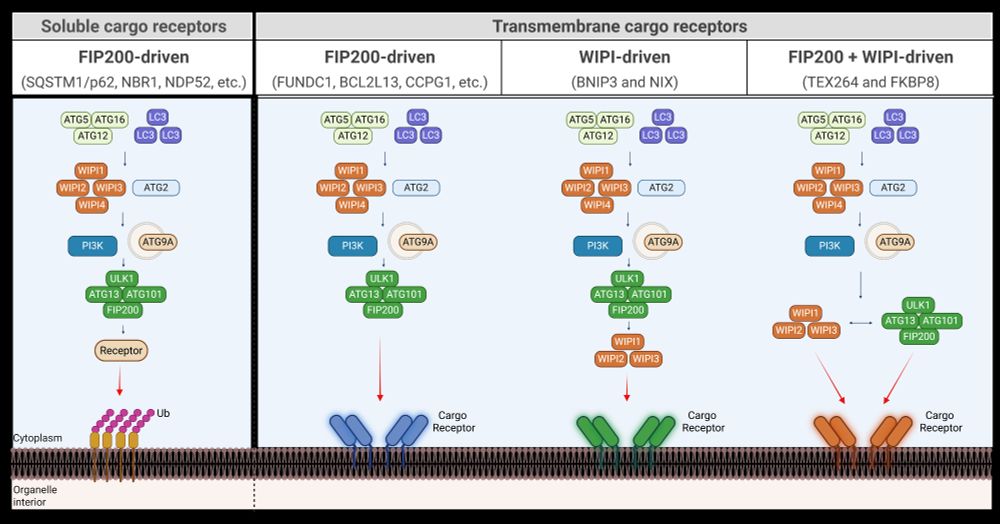
July 25, 2025 at 9:43 AM
And it's out!
I'm thrilled to share our new paper (Adriaenssens et al., Nat Cell Biol 2025).
This paper describes a new mechanism for the initiation of autophagosome biogenesis.
We found that this WIPI-ATG13-driven pathway is preferentially used by a group of transmembrane autophagy receptors.
I'm thrilled to share our new paper (Adriaenssens et al., Nat Cell Biol 2025).
This paper describes a new mechanism for the initiation of autophagosome biogenesis.
We found that this WIPI-ATG13-driven pathway is preferentially used by a group of transmembrane autophagy receptors.
Reposted by Aakriti Jain
A paper I have been working on with Oliver Lemke in the Ralser lab has just come out: www.nature.com/articles/s41...
We used predicted structures to gain insight into the evolution of metabolic proteins in yeast.
A bit more in this linked-in post (www.linkedin.com/posts/benjam...).
We used predicted structures to gain insight into the evolution of metabolic proteins in yeast.
A bit more in this linked-in post (www.linkedin.com/posts/benjam...).
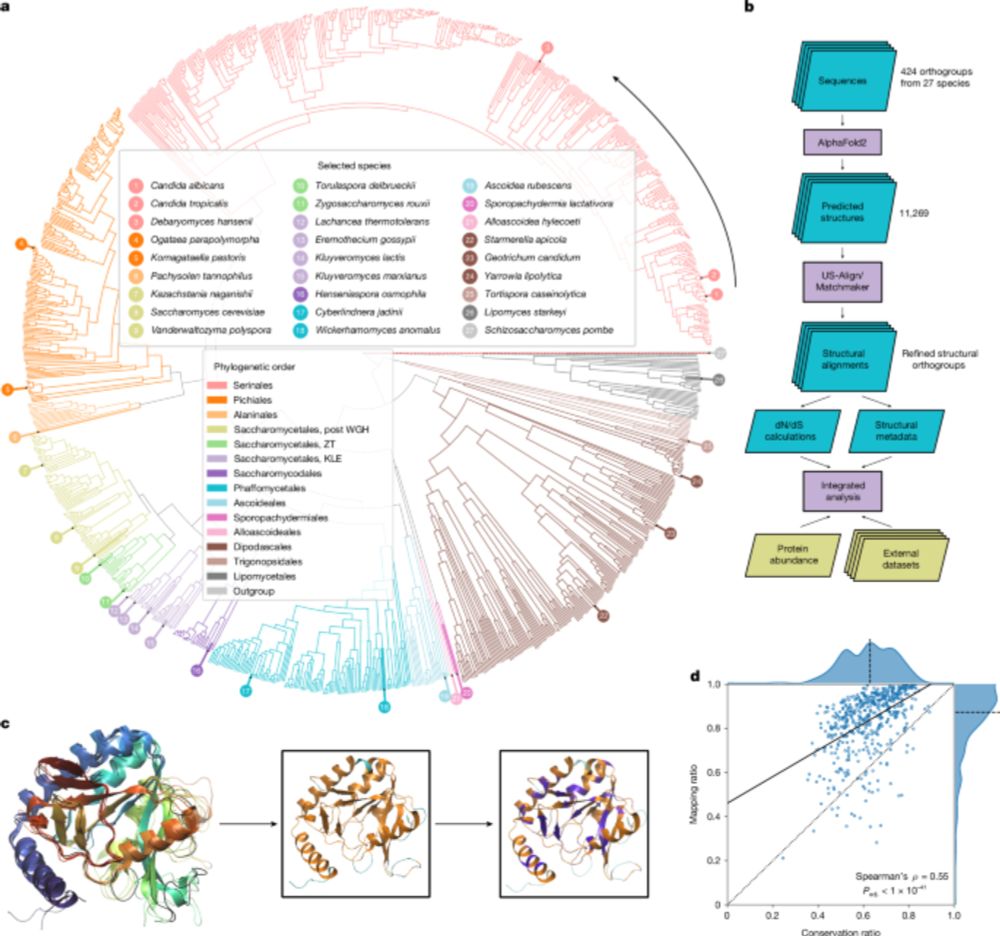
The role of metabolism in shaping enzyme structures over 400 million years - Nature
By combining structural biology and evolutionary genomics analyses, the evolution of enzymes over 400 million years is shown to be governed by catalytic function, metabolic network architecture, cost ...
www.nature.com
July 10, 2025 at 3:10 PM
A paper I have been working on with Oliver Lemke in the Ralser lab has just come out: www.nature.com/articles/s41...
We used predicted structures to gain insight into the evolution of metabolic proteins in yeast.
A bit more in this linked-in post (www.linkedin.com/posts/benjam...).
We used predicted structures to gain insight into the evolution of metabolic proteins in yeast.
A bit more in this linked-in post (www.linkedin.com/posts/benjam...).
Reposted by Aakriti Jain
We’re excited to share a new pre-print from the lab! Led by Carmen Ramirez Moncayo and a fantastic collaboration with several groups from across @mrc-lms.bsky.social & @imperialcollegeldn.bsky.social. Interested in #OvarianCancer, #PARPinhibitors or #DrugDistribution? please read on! bit.ly/45lpekS

June 11, 2025 at 8:11 PM
We’re excited to share a new pre-print from the lab! Led by Carmen Ramirez Moncayo and a fantastic collaboration with several groups from across @mrc-lms.bsky.social & @imperialcollegeldn.bsky.social. Interested in #OvarianCancer, #PARPinhibitors or #DrugDistribution? please read on! bit.ly/45lpekS
Reposted by Aakriti Jain
I am excited to share our new preprint! Led by @laylanassar.bsky.social , we have found a new JIP4-dependent mechanism that controls the efflux of cystine from lysosomes. Our findings have implications for both lysosome biology and human disease: doi.org/10.1101/2025...

JIP4 deficiency causes a novel lysosome storage disease arising from impaired cystine efflux
Lysosomes break down macromolecules, clear cellular waste and recycle nutrients such as cystine. We describe a novel mechanism whereby JIP4 regulates lysosomal cystine storage by controlling the abundance of cystinosin (CTNS), the transporter responsible for lysosomal cystine efflux. To this end, JIP4, previously characterized as a motor adaptor and kinase signaling scaffold, suppresses TMEM55B-dependent ubiquitylation of CTNS. Loss of JIP4 reduces CTNS protein levels, leading to lysosomal cystine accumulation and lysosomal storage defects that phenocopy loss of CTNS in both human cells and the renal proximal tubules of JIP4 knockout mice. These phenotypes mirror cystinosis, the lysosomal storage disease caused by CTNS loss-of-function. Our findings thus reveal a fundamental process that controls the efflux of lysosomal cystine and has relevance to understanding human disease arising from JIP4 mutations. ### Competing Interest Statement The authors have declared no competing interest. NIH, AG085824, AG062210, R35GM150619 Michael J. Fox Foundation, https://ror.org/03arq3225, ASAP-000580
doi.org
June 9, 2025 at 1:35 PM
I am excited to share our new preprint! Led by @laylanassar.bsky.social , we have found a new JIP4-dependent mechanism that controls the efflux of cystine from lysosomes. Our findings have implications for both lysosome biology and human disease: doi.org/10.1101/2025...
Reposted by Aakriti Jain
*ATG9A alert*👀👀
Curious about how ATG9A maintains lysosomal homeostasis via PI4P? Check out the new work from my postdoc in @satooze.bsky.social lab.
Thrilled to see this finally published!
Special thanks to @ealmacellas.bsky.social
www.sciencedirect.com/science/arti...
Curious about how ATG9A maintains lysosomal homeostasis via PI4P? Check out the new work from my postdoc in @satooze.bsky.social lab.
Thrilled to see this finally published!
Special thanks to @ealmacellas.bsky.social
www.sciencedirect.com/science/arti...
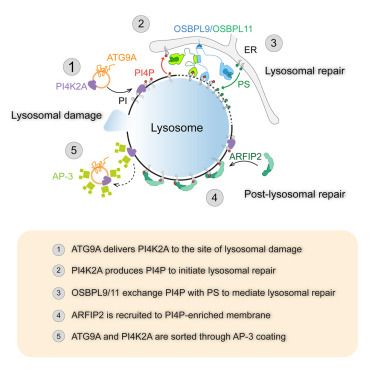
ATG9A and ARFIP2 cooperate to control PI4P levels for lysosomal repair
Lysosome damage activates multiple pathways to prevent lysosome-dependent cell death, including a repair mechanism involving endoplasmic reticulum (ER…
www.sciencedirect.com
June 3, 2025 at 7:22 AM
*ATG9A alert*👀👀
Curious about how ATG9A maintains lysosomal homeostasis via PI4P? Check out the new work from my postdoc in @satooze.bsky.social lab.
Thrilled to see this finally published!
Special thanks to @ealmacellas.bsky.social
www.sciencedirect.com/science/arti...
Curious about how ATG9A maintains lysosomal homeostasis via PI4P? Check out the new work from my postdoc in @satooze.bsky.social lab.
Thrilled to see this finally published!
Special thanks to @ealmacellas.bsky.social
www.sciencedirect.com/science/arti...
Only purifying fluorescently tagged proteins from now on - look at those beautiful mcherry fused proteins 😍💜

June 4, 2025 at 12:01 AM
Only purifying fluorescently tagged proteins from now on - look at those beautiful mcherry fused proteins 😍💜
Reposted by Aakriti Jain
Thrilled this paper is out! We solved the first cocrystal structure of FSP1 with an inhibitor (FSEN1), providing mechanistic insight & a foundation for medchem. Led by Amalia Megarioti & Sitao Zhang. A terrific collaboration with Da Jia.
Brief Skytorial!
1/9
Brief Skytorial!
1/9

Cocrystal structure reveals the mechanism of FSP1 inhibition by FSEN1 | PNAS
FSP1 is an FAD-dependent oxidoreductase that uses NAD(P)H to regenerate the reduced
forms of lipophilic quinone antioxidants, such as coenzyme Q10 ...
www.pnas.org
May 29, 2025 at 6:02 PM
Thrilled this paper is out! We solved the first cocrystal structure of FSP1 with an inhibitor (FSEN1), providing mechanistic insight & a foundation for medchem. Led by Amalia Megarioti & Sitao Zhang. A terrific collaboration with Da Jia.
Brief Skytorial!
1/9
Brief Skytorial!
1/9
Reposted by Aakriti Jain
New work @harvard by Miguel Gonzalez-Lozano @harperlabhms.bsky.social & @ernstschmid.bsky.social in Johannes Walter lab charts structural interactome of endosomes. #XL-MS #Alphafold Funded by @asapresearch.parkinsonsroadmap.org & NIH. Science continues-despite attacks www.nature.com/articles/s41...

EndoMAP.v1 charts the structural landscape of human early endosome complexes - Nature
A study presents EndoMAP.v1, a resource that combines information on protein interactions and crosslink-supported structural predictions to map the interaction landscape of early endosomes.
www.nature.com
May 28, 2025 at 3:52 PM
New work @harvard by Miguel Gonzalez-Lozano @harperlabhms.bsky.social & @ernstschmid.bsky.social in Johannes Walter lab charts structural interactome of endosomes. #XL-MS #Alphafold Funded by @asapresearch.parkinsonsroadmap.org & NIH. Science continues-despite attacks www.nature.com/articles/s41...
Reposted by Aakriti Jain
Online today in @nature.com - our latest study led by superstar postdoc Gilles Rademaker detailing the role of PSCK9 in driving sterol dependent metastatic organ choice in pancreatic cancer nature.com/articles/s41...
full text available here 👉 rdcu.be/em0VG and thread 👇
full text available here 👉 rdcu.be/em0VG and thread 👇
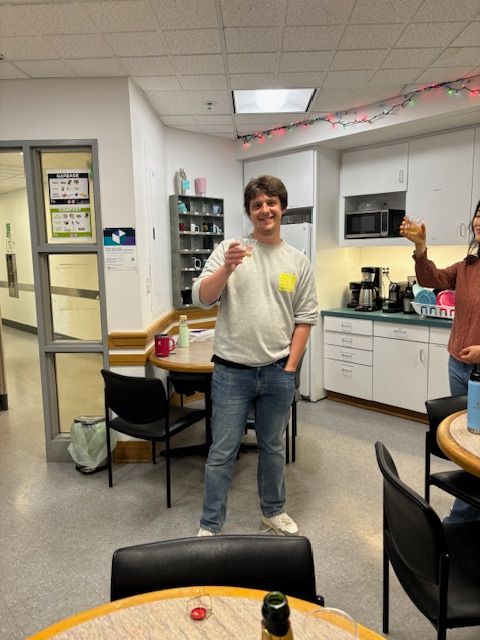
May 21, 2025 at 7:14 PM
Online today in @nature.com - our latest study led by superstar postdoc Gilles Rademaker detailing the role of PSCK9 in driving sterol dependent metastatic organ choice in pancreatic cancer nature.com/articles/s41...
full text available here 👉 rdcu.be/em0VG and thread 👇
full text available here 👉 rdcu.be/em0VG and thread 👇
Reposted by Aakriti Jain
mTORC1 is activated when cells are fed with amino acids. New preprint with @robzonculab.bsky.social led by Rachel Jansen shows how the massive "CastiGATOR" complex is formed when arginine-free CASTOR1 binds to the GATOR2 complex to antagonize mTORC1 starved cells. tinyurl.com/yr6en6f4

May 14, 2025 at 3:30 PM
mTORC1 is activated when cells are fed with amino acids. New preprint with @robzonculab.bsky.social led by Rachel Jansen shows how the massive "CastiGATOR" complex is formed when arginine-free CASTOR1 binds to the GATOR2 complex to antagonize mTORC1 starved cells. tinyurl.com/yr6en6f4
Reposted by Aakriti Jain
Here’s a new set of discoveries led by Francesca Filippini: doi.org/10.1101/2025...
We found that LRP10 promotes the efficient delivery of progranulin to lysosomes and that microglia are particularly sensitive to loss of LRP10.
We found that LRP10 promotes the efficient delivery of progranulin to lysosomes and that microglia are particularly sensitive to loss of LRP10.

LRP10 promotes trafficking of progranulin and prosaposin to lysosomes
Mutations in LRP10, a low-density lipoprotein receptor family member, cause familial Parkinson's disease and dementia with Lewy bodies. However, its direct cellular functions remain largely undefined....
doi.org
May 3, 2025 at 5:02 PM
Here’s a new set of discoveries led by Francesca Filippini: doi.org/10.1101/2025...
We found that LRP10 promotes the efficient delivery of progranulin to lysosomes and that microglia are particularly sensitive to loss of LRP10.
We found that LRP10 promotes the efficient delivery of progranulin to lysosomes and that microglia are particularly sensitive to loss of LRP10.
Reposted by Aakriti Jain
Move over mitochondria, a new organelle called the nitroplast is here.
In a Science study last year, researchers reported that a nitrogen-fixing organelle has been identified in a marine alga.
Learn more in this #SciencePerspective: scim.ag/49GjClc #ScienceMagArchives
In a Science study last year, researchers reported that a nitrogen-fixing organelle has been identified in a marine alga.
Learn more in this #SciencePerspective: scim.ag/49GjClc #ScienceMagArchives
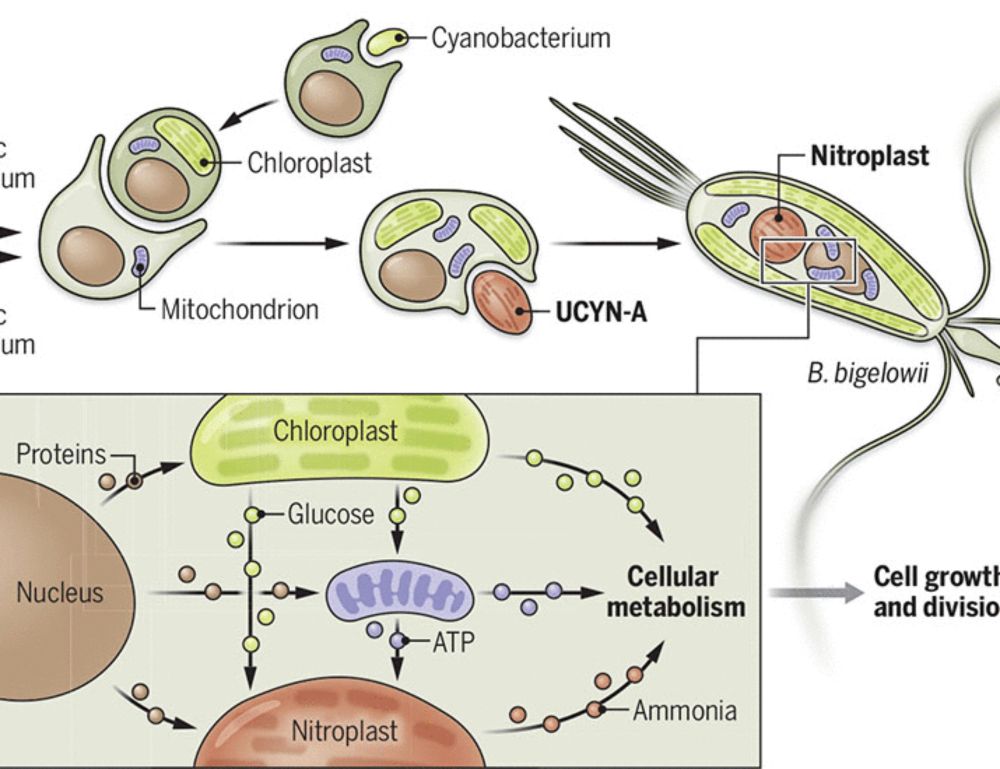
The nitroplast: A nitrogen-fixing organelle
A bacterial endosymbiont of marine algae evolved to an organelle
scim.ag
April 29, 2025 at 5:48 PM
Move over mitochondria, a new organelle called the nitroplast is here.
In a Science study last year, researchers reported that a nitrogen-fixing organelle has been identified in a marine alga.
Learn more in this #SciencePerspective: scim.ag/49GjClc #ScienceMagArchives
In a Science study last year, researchers reported that a nitrogen-fixing organelle has been identified in a marine alga.
Learn more in this #SciencePerspective: scim.ag/49GjClc #ScienceMagArchives
Reposted by Aakriti Jain
Our PKA-autophagy story by outstanding graduate student Ashley Segura (co-led with Rose Citron) published in @embojournal.org, dissects a deep connection between autophagy and PKA in neuronal signaling, with implications for neurological disease. Great collaboration with @manciaslab.bsky.social!
AKAP11 recruits PKA holoenzymes to #autophagosomes in a bidirectional functional association, both promoting downstream PKA signaling and increasing AKAP11-PKA complex degradation
@robzonculab.bsky.social @ucberkeleyofficial.bsky.social
www.embopress.org/doi/full/10....
@robzonculab.bsky.social @ucberkeleyofficial.bsky.social
www.embopress.org/doi/full/10....

April 23, 2025 at 3:03 PM
Our PKA-autophagy story by outstanding graduate student Ashley Segura (co-led with Rose Citron) published in @embojournal.org, dissects a deep connection between autophagy and PKA in neuronal signaling, with implications for neurological disease. Great collaboration with @manciaslab.bsky.social!
Reposted by Aakriti Jain
Happy to share the first paper in my PhD is published in JCB!
It's my honor to work with amazing teammates! I really enjoy exploring mitochondrial protein import mechanism through cryo-ET!
It's my honor to work with amazing teammates! I really enjoy exploring mitochondrial protein import mechanism through cryo-ET!
Cytoplasmic #ribosomes on #mitochondria alter the local membrane environment for protein import, say Ya-Ting Chang, Danielle Grotjahn (@nanigrotjahn.bsky.social) @scripps.edu and colleagues: rupress.org/jcb/article/...
#ProteinHomeostasis #Organelles #StructuralBiology #CryoET
#ProteinHomeostasis #Organelles #StructuralBiology #CryoET
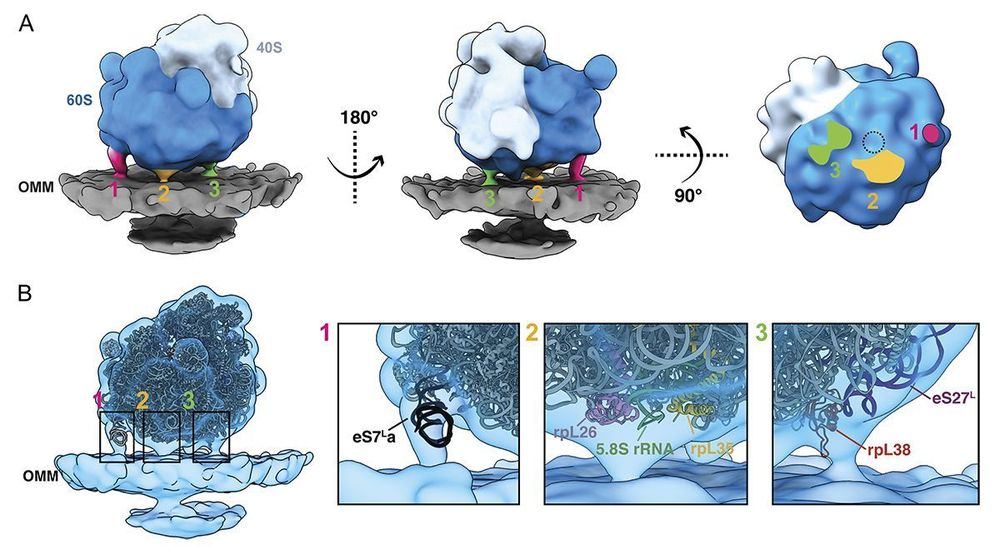
April 9, 2025 at 5:29 AM
Happy to share the first paper in my PhD is published in JCB!
It's my honor to work with amazing teammates! I really enjoy exploring mitochondrial protein import mechanism through cryo-ET!
It's my honor to work with amazing teammates! I really enjoy exploring mitochondrial protein import mechanism through cryo-ET!
Reposted by Aakriti Jain
Despite daily disruptions, scientists try to use logic and creativity to help fellow humans.
Thus I would like to report our latest work describing microbial-independent deep assembly and screening, a method that goes from primers to mammalian cell assays in 1 day.
www.biorxiv.org/content/10.1...
Thus I would like to report our latest work describing microbial-independent deep assembly and screening, a method that goes from primers to mammalian cell assays in 1 day.
www.biorxiv.org/content/10.1...

Rapid optimization of protein function in mammalian cells via microbe-independent deep assembly and screening
Random mutagenesis and deep mutational scanning (DMS) are widely used to optimize proteins by oversampling large libraries in microbial cells, selecting cells expressing favorable variants, and sequen...
www.biorxiv.org
April 4, 2025 at 5:15 PM
Despite daily disruptions, scientists try to use logic and creativity to help fellow humans.
Thus I would like to report our latest work describing microbial-independent deep assembly and screening, a method that goes from primers to mammalian cell assays in 1 day.
www.biorxiv.org/content/10.1...
Thus I would like to report our latest work describing microbial-independent deep assembly and screening, a method that goes from primers to mammalian cell assays in 1 day.
www.biorxiv.org/content/10.1...
Reposted by Aakriti Jain
Groundbreaking study in Cell from @leventallab.bsky.social: phospholipid asymmetry is a defining feature of the plasma membrane and cholesterol fills the holes — major implications for how this membrane works. A #lipidtime must-read! www.cell.com/cell/abstrac...
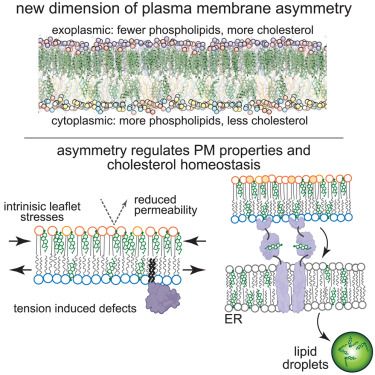
Cell membranes sustain phospholipid imbalance via cholesterol asymmetry
This work challenges a major assumption in cell biology by showing that lipid bilayers
can have drastically different phospholipid abundances between their two leaflets.
This lipid abundance asymmetry...
www.cell.com
April 3, 2025 at 3:07 PM
Groundbreaking study in Cell from @leventallab.bsky.social: phospholipid asymmetry is a defining feature of the plasma membrane and cholesterol fills the holes — major implications for how this membrane works. A #lipidtime must-read! www.cell.com/cell/abstrac...
Reposted by Aakriti Jain
Striking new study from @archaeon-alex.bsky.social's lab just out in @science.org on multicellular development induced by compression in Archaea: www.science.org/doi/10.1126/...
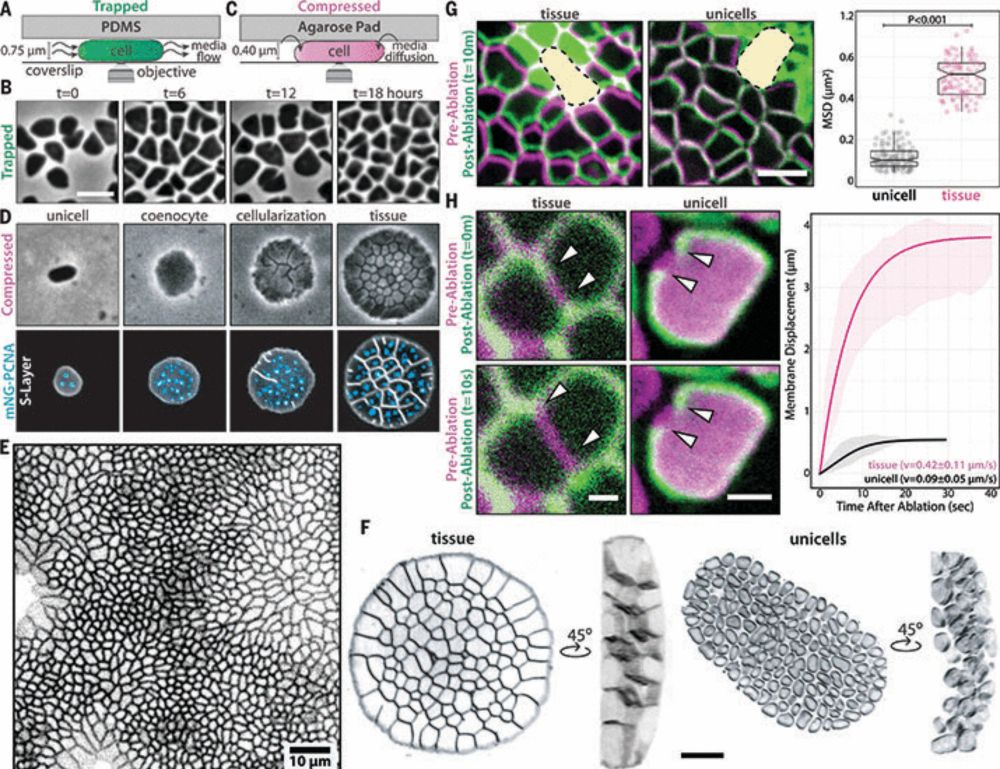
Tissue-like multicellular development triggered by mechanical compression in archaea
The advent of clonal multicellularity is a critical evolutionary milestone, seen often in eukaryotes, rarely in bacteria, and only once in archaea. We show that uniaxial compression induces clonal mul...
www.science.org
April 3, 2025 at 6:24 PM
Striking new study from @archaeon-alex.bsky.social's lab just out in @science.org on multicellular development induced by compression in Archaea: www.science.org/doi/10.1126/...
Reposted by Aakriti Jain
Exciting discovery by Aakriti Jain @aakritijain.bsky.social et al of the @robzonculab.bsky.social lab that LyLAP processively and rapidly proteolyses membrane-spanning hydrophobic domains of transmembrane proteins!
SO excited to share that a major part of the postdoctoral work in @robzonculab.bsky.social lab is now published: “Leucine aminopeptidase LyLAP enables lysosomal degradation of membrane proteins” www.science.org/doi/10.1126/...

Leucine aminopeptidase LyLAP enables lysosomal degradation of membrane proteins
Breakdown of every transmembrane protein trafficked to lysosomes requires proteolysis of their hydrophobic helical transmembrane domains. Combining lysosomal proteomics with functional genomic dataset...
www.science.org
March 30, 2025 at 3:25 AM
Exciting discovery by Aakriti Jain @aakritijain.bsky.social et al of the @robzonculab.bsky.social lab that LyLAP processively and rapidly proteolyses membrane-spanning hydrophobic domains of transmembrane proteins!

